"*" indicates required fields
On-Page SEO: how to optimize your web pages

There’s one thing I want to clarify before we get into this.
In the world of SEO, optimization is NOT exclusive to the use of keywords and on-page optimizations.
For example, you can make technical optimizations to a page by compressing images (making them smaller) and all kinds of other fixes that will help the webpage speed or other factors.
With that being said, this article is focused on on-page optimizations and how to do it with the help of a case study.
Case study: on-page optimizations for Kingfisher Home Inspections
Let’s walk through an example of how to optimize your page for a keyword.
Michael, owner of Kingfisher Home Inspections, provides three main services: home inspections, septic inspections, and WETT inspections.
For the sake of this case study, we’re going to focus on one service: WETT inspections.
The first thing we did was identify the keywords we want to include for the on-page optimizations.
We discovered that “WETT inspection” had a great search volume, and the SEO difficulty was easy, which meant that this was an ideal keyword to use.
We also discovered “what is a WETT inspection” within the keyword ideas section, and realized this was a great secondary keyword to include on the page due to it’s low competition.
Once we had our main keyword ‘wett inspection’, and a secondary keyword ‘what is a wett inspection’ we took a look at his current content to see whether it was currently present.
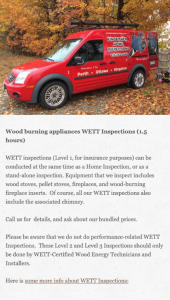
Above is what his page looked like and below is a table with features we want to optimize.
| Metrics | Before On-page Optimizations |
| Word count | 102 words |
| Keyword density | Inspections – 14 Wett – 8 wett inspections – 8 What is a wett inspection – 0 |
| Headings | None |
| Keyword in first paragraph | Yes |
| Meta title | None |
| Meta description | None |
| ALT and title text | None |
| Links | None |
There is a decent amount of keyword density for the main keyword, but no meta description, no meta title, no headings, and a low word-count of 102 words.

Boost your online presence with our help
- Web design and development
- SEO and PPC
- Social media strategy
- AI technology
Given this information, we decided to optimize the content on his WETT Inspections page in a variety of ways:
- Increased the word-count by adding interesting content for the user (remember, this must always come first), and ensured at least the same amount of keyword density, since it was already relatively high.
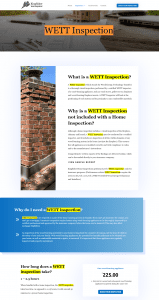
- Structured the content with subheadings. Subheadings are the titles that help differentiate the content from one another. They help place an emphasis on certain keywords through the HTML code but also help provide a better user experience.
- Included the keyword within the very first paragraph. In fact, we were able to include both the shorter tail keyword ‘’WETT inspection’’ and the secondary long-tail keyword ‘’What is a WETT inspection’’ at the same time.
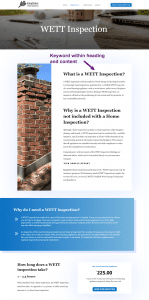
- Ensured the meta title, meta description, and slug contained WETT inspection. In order to adjust this, we used a WordPress plugin called SEO YOAST. The plugin is really useful, as it provides live feedback, and makes recommendations for your on-page optimizations. It basically acts like an SEO checklist.
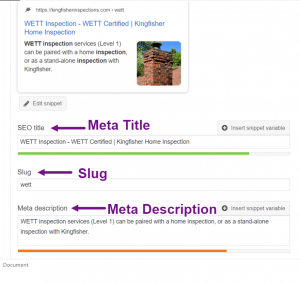
- Added an alternative and title text to the image present on the page. It’s important to describe the picture all the while trying to include words relevant to the page.
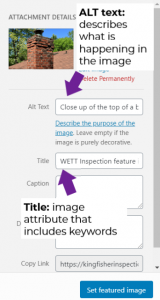
- Added internal links to the other services offered. This helps create a seamless navigation between his pages, which appeals to both users and search engines. Sometimes, it also makes sense to add outlinks, which are links to pages on other websites. But in this case, we chose not to do that.
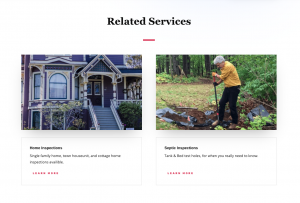
As you can see from the before and after table comparison, we managed to improve different SEO aspects of the webpage.
| Metrics | Before On-page Optimizations | After On-page Optimizations |
| Word count | 102 words | 454 words |
| Keyword density | Inspection – 14 Wett – 8 time wett inspection – 8 | Inspection – 31 Wett – 16 Wett inspection – 13 |
| Headings | None | Page implements HTML headings H1 – H3 |
| Keyword in first paragraph | Yes | Yes |
| Meta title | None | WETT Inspection – WETT Certified | Kingfisher Home Inspection |
| Meta description | None | WETT inspection services Level 1 can be paired with a home inspection, or as a stand alone inspection with Kingfisher |
| Alt and title text | None | Present |
| Links | None | 2 internal links |
It’s important to clarify that on-page optimizations are NOT about ‘’keyword stuffing’’, but rather a holistic approach to a higher word-count and strategic keyword placements.
Of course, there is always more that can be done to increase the page rank, and moving forward we could continue to add even more text, and increase the keyword density as we do, along with secondary keywords and synonyms. We can also add other pages on this topic, such as blog posts, or even portfolio pages outlining his work on this service.
For SEO to work most efficiently, it’s important to measure the progress, stay on top of competitors, and continue to do more on-page optimizations with future content!
Let's chat about your goals
OR tell us more about you
Swipe up for expert help!





